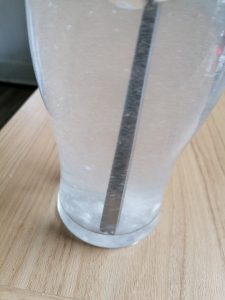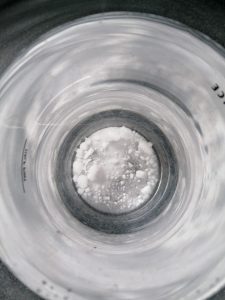When taking supplements for athletic performance, body composition, or other gym-related benefits the focus is too often on “what to take” and not necessarily “how you should take the supplements”.
The reason I mention this, is because there are optimal ways to take most supplements – whether this is timing, quantities, or even how you take them (mixing, empty stomach, etc…). Something people often observe but never pay attention to when supplementing with creatine is creatine not dissolving fully when mixing it with water or other liquids.
It’s easy to ignore this and continue drinking the cloudy mixture with creatine swirling around the glass or shaker but is this something you should be paying more attention to?
In this article, I’ll cover why you should take fully dissolved creatine and how best to mix your creatine for maximum benefit.
Creatine Not Dissolving
Creatine monohydrate is a popular supplement that comes in different forms including capsules and powders. When using the powdered form of creatine, a lot of people experience issues with getting all of the product to dissolve.
If you’ve ever been ready to take creatine – only to see the granules floating around the glass or shaker bottle creating a cloudy liquid (or noticed the creatine just sinks to the bottom and doesn’t then dissolve) – then you’ve also likely wondered if this is a safe or correct way to consume your creatine.

Here I’m going to address some of the most popular questions and debates around dissolving powdered forms of creatine to make sure you’re getting the most out of your product!
Does Creatine Need to Dissolve
Creatine should always be fully dissolved in liquids before you consume it. This is because creatine is an osmolyte which means that it draws in water from surrounding areas. So it can cause side effects like stomach aches, cramping, and bloating if it hasn’t been completely dissolved.
As well as potentially causing side effects, undissolved creatine has a gritty texture and is more likely to stick to the glass. If it’s sticking to the glass then it’s not being absorbed into your muscles. So dissolving all of the creatine product means that you’ll be using it most effectively and be getting the most out of it.
Related – Can you dry scoop creatine
Does It Matter if Creatine Is Not Dissolved
There’s no definitive evidence to suggest that undissolved, or poorly dissolved, creatine is any less effective than fully dissolved creatine. So in terms of your overall goals with using creatine, it doesn’t necessarily matter if all the creatine product has fully dissolved.
However, whilst the creatine product isn’t less effective when it’s poorly dissolved like I already mentioned it can cause side effects when not completely dissolved.
One of the main issues people have when taking creatine is that it can cause bloating and water retention. Water retention in the muscle is good and beneficial but when it comes to bloating, the cause of this is usually creatine that is not fully dissolved draws water into the stomach, and ultimately causes stomach aches and bloating.
So the bottom line is it does matter if the creatine is dissolved and you should always fully dissolve creatine before you consume it.
How to Fully Dissolve Creatine
A lot of people have issues when trying to get creatine to fully dissolve. The good news is that there are lots of things you can do to make sure that creatine fully dissolves, which I’ll now explain.
To fully dissolve creatine one of the best things you can do is use warm liquids, like warm water, juice, or tea. This is because warm water improves solubility meaning that it is much more effective in breaking down the product and causing it to dissolve than cold water. So always use warm water to get a better result.
Check out this video which talks about using warm and cold liquids with creatine:
You also need to make sure you have the right liquid to creatine ratio. For the creatine to fully dissolve there needs to be sufficient liquid. Most products recommend 3 grams of creatine monohydrate in a full glass of water. Not having enough liquid will prevent the creatine from fully dissolving and you’ll be left with big particles in the glass.
It sounds obvious but stirring or shaking is also important to enhance dissolving, as stirring causes the particles to move around which helps to break them down faster and more effectively. Once you’ve added the product to the water you should stir continuously for at least thirty seconds. Keep stirring until you can tell that the product is completely dissolved into the liquid. If 30 seconds doesn’t work and you need to take longer – take longer!
You should also drink the mix as soon as the creatine has dissolved into the liquid. If you leave it for too long then eventually the particles of creatine will start to sink and collect at the bottom of the glass rather than being suspended in the water. So consuming it quickly once the product has dissolved is best.
To summarize then, always use a sufficient amount of warm liquid to dissolve creatine. Make sure you stir the mix and always drink it as soon as the creatine has completely dissolved.
Why Does Creatine Not Mix Well
If you find that you’re still having issues with getting creatine to dissolve after using the methods I’ve discussed in the last section then it may be the quality of the product you’re using. Some of the lower grade products have poor solubility, meaning that they don’t dissolve well. It’s important to use high-grade products that are going to break down fully.
You could also try micronized creatine. Micronized forms of creatine have particles that can be 10 or more times smaller than regular creatine. Because the particles are smaller it dissolves quicker and more easily in liquids so you’re going to get a better result when mixing it in water.
Creatine Sinking to the Bottom of the Glass
If your creatine hasn’t fully dissolved then the bigger and heavier particles end up sinking to the bottom of the glass, rather than being suspended in the liquid. So seeing creatine collecting at the bottom of the glass is a clear sign that it hasn’t dissolved properly.
This isn’t ideal because these bigger creatine particles will stick to the glass. If it’s stuck to the glass then you obviously won’t be consuming and absorbing the amount you want to.
To make sure that creatine doesn’t sink to the bottom of the glass check out the section on how to get creatine to fully dissolve.
Why Is Creatine Gritty
Creatine monohydrate has a slightly gritty, sand-like texture. It is water-soluble though so this texture should change when it has been fully dissolved in liquid.
If you find that your creatine still has a gritty texture when you’ve tried to dissolve it then it’s a sign that it hasn’t completely broken down. Most of the time this gritty texture is worst towards the bottom of the glass because that’s where the undissolved creatine will collect.

So, to get rid of this gritty texture make sure the creatine has completely dissolved in a liquid before you drink it. If this gritty texture really bothers you I’d also recommend the micronized form of creatine. As I mentioned, this creatine has smaller particles, so it doesn’t have the same gritty texture as regular creatine monohydrate.
In Summary
If you’ve been scooping your creatine into a glass or shaker and then drinking it straight away, chances are the creatine has not fully dissolved and as a result, you won’t receive the full benefit from each scoop.
Supplements work best when taken according to the manufacturer’s recommendation and if you’re consuming gritty, undissolved creatine then you’re likely already wondering why it isn’t mixing properly?
To ensure creatine is fully dissolved before consuming it, make sure you use adequate liquid (200ml per 3g creatine as a guide) and shake or stir the creatine rather than letting it sink to the bottom.
The key area where people go wrong when mixing creatine is using ice-cold water. This reduces the solubility and means the creatine will take much longer to dissolve. Therefore, try adding it to warm water or tea to speed up the rate at which it dissolves.
